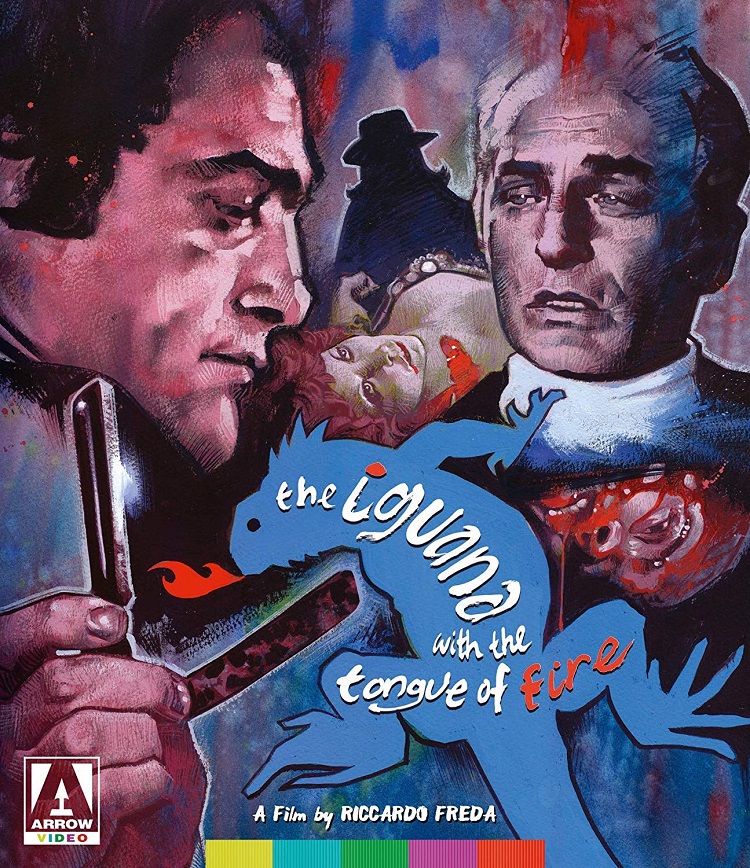
Following the success of Dario Argento’s The Bird with the Crystal Plumage, Italian cinema was awash in lurid crime stories with baroque titles featuring one animal or another. The Iguana with the Tongue of Fire came out about one year after Argento’s quintessential giallo, and it’s clearly aping some of that films tropes while also blending in poliziotteschi crime elements. It has a masked killer, graphic violence, and lurid sexuality, but it’s told in a much more conventional way without the typical giallo camera flourishes and wild color schemes. It is much more centered on the crime, catching the killer, while also maintaining a plot that is as confusing as any movie put out by Argento and his followers.
A woman has acid thrown into her face and her throat slashed by sunglasses-wearing killer. Later, her corpse shows up in the trunk of Ambassador Sobieski (Anton Diffring) car. He claims he doesn’t know the woman but he’s definitely shady about it. When more bodies start piling up, he uses his diplomatic immunity to keep the cops at a distance. On the case is Detective John Norton (Luigi Pistilli), a rogue cop whose unorthodox methods keep getting him into trouble. He goes through a long list of strange, quirky characters, all of whom could be the killer. All the while more and more people keep getting killed, all of whom have some connection to the Ambassador.
Since the Ambassador is using his immunity to keep Norton at arm’s length, he decides to get closer to his daughter Helen (Dagmar Lassander). But that leads to nowhere. Almost everything leads to nowhere as it is a film full of red herrings and hints and clues that ultimately mean nothing. The camera has a tendency to quick zoom onto objects while the musical score gives us a sting, letting us believe these things are important. For example, nearly everyone owns a pair of sunglasses that we see on the killer in that opening scene and the film always makes us notice that fact. But if everyone owns those sunglasses, then it’s not really a clue, now is it?
Honestly, the plot got lost on me pretty quickly. We get multiple flashbacks to a day when Norton was interrogating a suspect (by torturing him it seems) only to have the suspect grab Norton’s gun from his holster and commit suicide (the camera the lingers on the splattered brain matter sliding down the wall). We spend quite a bit of time with Norton’s nearly deaf and blind mother and his young daughter for no real reason. Characters come and characters go, all of which whom could be the killer, but instead of being intriguing, I kept getting more and more confused.
Confusing plots are nothing new to giallo films, but usually there is enough style to keep me from caring too much. But the style here is so straightforward that there was nothing to cling to but the confusion. There are some interesting scenes and it is well enough made that I wasn’t completely bored, but there wasn’t enough to keep me really excited either. The main saving grace is it location. It is set in Dublin and there are some nice views around the city. There is a beautiful scene set near the Cliffs of Moher and another on the Swiss Alps. There are absolutely no reason for these scenes to take place there, but it is pretty. Overall, it’s a pretty middle of the road giallo, that’s worth seeing if you are a fan, but definitely not a good starter film for the genre.
Arrow Video presents The Iguana with the Tongue of Fire with a new 2K restoration from the original 35mm element. It has a 1080p transfer and an uncompressed mono 1.0 LPCM audio with an aspect ratio of 1.85:1. Extras include audio commentary from Adrian J. Smith and David Flint. There are video appreciations of the film and of the score. Plus, there is a new interview with Dagmar Lassander and the usual trailers, image galleries, and full-color booklet with an essay on the film.